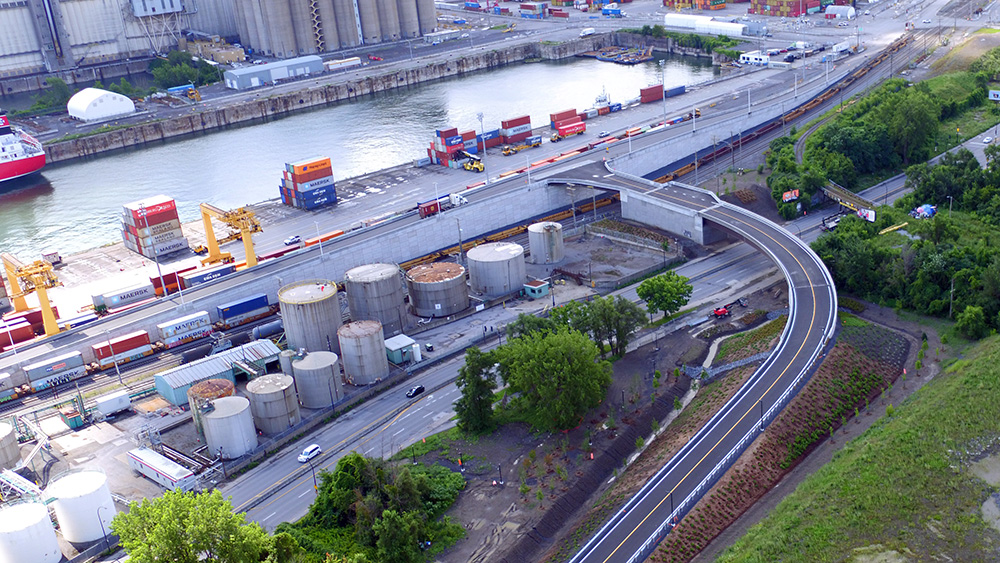
Smooth, efficient traffic flow: the Port of Montreal opens its new overpass in the Viau sector
Press release
Montreal, August 9, 2023—After two years of construction, the Port of Montreal has officially opened its new overpass over Notre-Dame Street East in the Viau sector. Intended to remove close to 1,500 trucks a day from the local road network, this new infrastructure will improve the efficiency and fluidity of freight transport.
Providing a direct connection between bulk and container terminals, the new overpass opened by the Montreal Port Authority (MPA) will enable trucks leaving the Port of Montreal to take Dickson Street then Souligny Avenue directly to Highway 25. This will make it possible for about 1,500 trucks a day to bypass Notre-Dame Street. In addition to saving time for truck drivers, ensuring a smoother flow of goods and improving the efficiency of port operations, this new infrastructure will limit disruptions for residents of the Mercier-Hochelaga-Maisonneuve borough.

Public hearings and lasting infrastructure development
To ensure harmonious integration into the urban fabric and address the concerns of neighbouring communities, the MPA followed a thorough consultation and information process throughout the project. In all, three public consultations were held at key stages during the project’s planning phase to define the major orientations and enhance the concept. The new infrastructure features a number of eco-responsible attributes, such as efficient rainwater management with drainage channels, the integration recycled glass in certain concrete components, and lighting in compliance with International Dark-Sky Association (IDA) standards.
“The Port of Montreal’s new overpass meets ambitious objectives not only in terms of operational efficiency, but also how we cohabit with neighbouring communities. It will make it possible to streamline the flow of goods, while blending harmoniously into the urban landscape and presenting a sleek design,” said David D’Amboise, Vice-President, Asset Management and Port Logistics at the MPA.
Valuable support from the Government of Canada and the Government of Quebec
Begun in June 2021, construction of the overpass represents a total investment of $47.8 million.
To successfully complete the project, the MPA received $6,7 million in financial support from the Quebec government for the construction and rehabilitation of marine infrastructure (Avantage Saint-Laurent).
The MPA was also able to count on financial support from the federal government as part of the National Infrastructure Component of the New Building Canada Fund, totalling $7.7 million.
Next steps
By the end of the summer, the project will be fully completed, with architectural integration, landscaping featuring many trees and an artistic component developed in collaboration with the Molinari Foundation.
The overpass is accessible to trucks via the Port’s temporary road to Dickson Street. This temporary road will be removed once the extension of Assomption Boulevard and Souligny Avenue have been completed by the Ville de Montréal and the Ministry of Transport and Sustainable Mobility respectively.
To learn more about the overpass, visit our project webpage
Operated by the Montreal Port Authority (MPA), the Port of Montreal is the second largest port in Canada and a diversified transshipment centre that handles all types of goods: containerized and non-containerized cargo, liquid bulk and dry bulk. The only container port in Quebec, it is a destination port served by the largest shipping lines in the world. It is also an intermodal hub with a service offering that is unique in North America, featuring its own rail network directly dockside connected to Canada’s two national rail networks. The MPA also operates a Cruise Terminal and a Port Centre. The MPA factors economic, social and environmental components into its corporate initiatives. This commitment is governed by a sustainable development policy whose guiding principles focus on involvement, cooperation and accountability. Port activity supports 19,000 jobs and generates $2.6 billion in economic benefits annually.About the Port of Montreal
— 30 —

